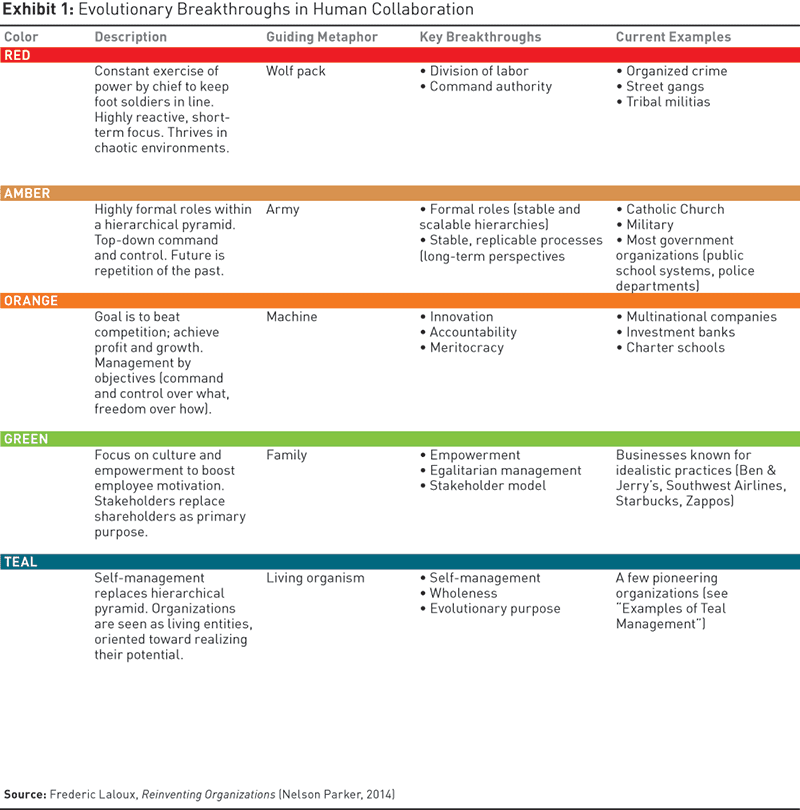Designing a roadmap to increase autonomy and to distribute authority in your organization.
People don’t need to be empowered, as I explained in a previous article. They are already powerful. What people need is the autonomy and authority to make decisions.
Our brains are wired to self-direct. We don’t want to be told what to do because we want to be in control.
That’s why autonomy and distributed authority are crucial to building self-organized teams. Making smarter and faster decisions requires enabling those who are closer to the information, not to the source of power―but getting there is not easy.
Replacing a command-and-control model with a self-managed one requires intentionality, clarity, and practice.
Alice: Which way should I go?
Cat: That depends on where you are going.
Alice: I don’t know.
Cat: Then it doesn’t matter which way you go.
Lewis Carroll, Alice in Wonderland
Self-organization means becoming accountable to the purpose of the company rather than to the manager. It starts by being responsible for yourself and your team, not your boss.
In this post, I will cover the benefits of self-organizing and critical ways to get your team started. I will also share how innovative organizations distribute authority and self-regulate to overcome unexpected problems.
What is self-organization (and why does it matter)?
As systems evolve over time, their natural tendency is to become increasingly more complex. Organizations need a simpler, more adaptive way of working: one that facilitates agility.
Self-organization is about pleasing the company’s purpose, not your boss. Morning Star describes it as a model in which the traditional functions of managers are distributed across teams.
This approach makes each colleague responsible for their own work, relationships, goals, and actions. Increased autonomy makes people more collaborative. They are more mindful of how their actions affect others.
A self-organizing team has authority over its work and the processes it uses.
Is it self-organizing or self-management?
Most people use both terms interchangeably. I prefer self-organizing because it captures an adaptive behavior. The flocking of birds in flight or an ant colony are perfect examples of self-organized systems.
Self-organization means giving people an active role in the transformation of the organization. It requires involving them in the design and execution of their future.
The three key benefits of a self-organized company are:
- Accelerates team buy-in and shared ownership
- Leverages internal motivation (autonomy) leading to high performance
- Builds an innovative and creative culture that drives growth
Should the team make all the decisions then?
It depends on how far you want to go.
Self-organization doesn’t mean the absence of authority. Instead, decision-making is distributed across the company. How far you want to take it depends on the model you choose. But, most importantly, on the maturity of your workplace culture.
Becoming self-organized is a long, long journey; it requires a lot of time and practice.
Self-organization is the emergent organizational model
“It’s the job of the manager not to light the fire of motivation, but to create an environment to let each person’s personal spark of motivation blaze.”
Frederick Herzberg
In Reinventing Organizations, Frédéric Laloux states that the future of management is ‘Teal.’ The author uses a color-coded developmental model to showcase the evolution of organizations.
‘Teal’ is the newly emergent social organization model. Teal organizations are decentralized and adaptive. They approach problems with a “sense and respond” mindset versus a “predict and control” one.
People that work at Teal organizations bring their whole selves to work. They operate on trust rather than fear. This type of organization encourages people to lead from within; employees are more present and authentic.

One paradigm is not better than the other. Each stage is designed to deal with certain complexities and contexts.
Self-managing organizations are nothing new, though. Their origin can be traced back to the 1940s. But, as Ori Brafman explains in The Starfish And The Spider, decentralized organizations have existed for centuries.
Take the Apaches, for example. These American Indians had a leaderless structure with distributed power and knowledge. Their organization was flexible, had no central headquarter, and was structured around fluid roles―not titles.
The problem with the notion of Teal organizations is that it’s become a hype. There are many myths that position self-organizations as utopian workplaces.
Being Teal has become cool.
However, very few organizations fall into that category. Examples such as Morning Star or Buurtzorg appear over and over in most self-organization articles.
My point is: avoid approaching self-organization with a perfectionist mindset. Rather than obsessing about becoming Teal, design the right model for your organization.
The key aspects to start with self-organization
Laloux identifies five key elements to start building a self-managed company.
1. A shift from titles to roles
2. Replace annual performance reviews with ongoing, peer-to-peer feedback
3. Encourage people to resolve conflict productively on their own without managers’ intervention
4. Distribute authority to make decisions — liberate those who are closer to the information or the problem
5. Turn transparency in a way of life by sharing the information people need to do their jobs
Adopting these new ways of working requires providing people with two things:
– Autonomy
– Psychological Safety
Autonomy is the freedom to act and to make our own choices. It fuels internal motivation, not an external one. When people feel in charge of their decisions, they are more engaged, collaborative, and productive.
Promoting autonomy is much more useful than “empowering people.” However, autonomy alone is not enough.
People also need to feel safe to experiment with new behaviors and address tensions.
High-performing teams need psychological safety. Organizations must create a culture where people feel safe to speak up and be authentic.
Psychological safety is the shared belief that a team is safe for interpersonal risk-taking. It’s a culture where people don’t fear the consequences of being candid; participation is encouraged rather than silenced.
Balancing Autonomy and Psychological Safety is key to building a self-organized culture.
The purpose of this chart is to illustrate the progression. It’s not intended to be ‘the ideal’ roadmap. As the saying goes, “All roads lead to Rome.”
The order is based on my personal experience advising organizations. Coaching people to address conflict as a team is easier to achieve than developing a culture of Radical Transparency.
Building on the above, the idea that Radical Transparency is in the last place doesn’t mean you have to wait until the end. It’s a progression. You must work on developing all five aspects―but some require more time, practice, and cultural maturity.
For example, adopting “Salary Transparency” is a practice that makes most organizations uncomfortable. Though it’s the quintessential expression of openness, it usually takes more effort for a company to adopt it.
Autonomy and authority go hand in hand. Encouraging people to behave more autonomously makes no sense if they don’t have the power to make decisions.
Five ways self-organized companies distribute authority
1. Distribute authority equally
Morning Star has a single, simple rule. The world’s largest tomato processor company gives everyone the same amount of power. Any employee has the ability to solve conflicts and make changes without the need for approval.
As Paul Green, Jr., formerly responsible for Morning Star’s training and development, explains: “People are happiest when they have personal control over their lives. The best human organizations are those in which people aren’t managed by others, but in which participants coordinate among themselves, managing their own relationships and commitments to others.”
2. Align on the mission, let people choose how
Accountability is the result of balancing alignment and autonomy.
Spotify’s Aligned Autonomy approach encourages leaders to align teams around a common mission and then let them figure out the solution.
Any imbalance across the two dimensions creates failure at scale. Spotify leaders don’t ask teams to build a bridge; they align people on the mission (we must cross the river) and then let them figure out how.

3. Create simple rules
To shape their high-level strategies, companies must rely not on complicated frameworks, but on simple rules of thumb.
“Simple Rules,” a term coined by Donald Sull and Katherine Eisenhardt, are just-in-time structures that help teams deal with obstacles.
When a bottleneck arises, leaders identify the problem and come up with a simple rule to help people make decisions. Once they’ve established the criteria, leaders step out the way.
In IDEO’s early days, clients often wanted to rush through the brainstorming process. That approach leads to fewer great ideas. To overcome this, IDEO’s founders came up with the following simple rules:
“Defer judgment.”
“Encourage wild ideas.”
“Go for quantity.”
4. Distributed risk mitigation
Distributing authority increases risks. Organizations should turn risk mitigation into everyone’s responsibility, as Deborah Ancona and Kate Isaacs wrote here.
The authors cite the example of how the mining company Anglo American dramatically reduced the number of fatalities; the organization made it safe for its over 30,000 workers to share their ideas.
By using a traditional South African village assembly, a lekgotla, everyone contributed to creating a work environment of care and respect.
5. Set up an advice process
The Advice Process was coined by Dennis Bakke, former CEO of AES Corporation, an electrical power firm. The goal of an advice process is to balance the rights and needs of the individual with the interests of the larger organization.
As Bakke explains, “Every decision made at headquarters takes away responsibility from people elsewhere in the organization and reduces the number of people who feel they are making an effective contribution to the organization.”
The initiator gathers input before presenting a proposal. They then seek advice from those affected by it, or those with expertise.
The advice process leaves the final decision to individuals, but it forces them to weigh the interests of the bigger community.
Don’t fear self-organization; let the system self-correct.
The journey toward adopting self-organization is a bumpy road. Be ready for unexpected problems to appear.
Many companies quit too early in the game because they expected a smooth transition. Change is human and messy.
Frédéric Laloux recommends that we focus on the overall system rather than if a few employees abuse their new freedom.
In traditional organizations, the boss must intervene to solve conflicts and fix issues. In self-organizations, the system self-corrects without involving managers.
Here are some mechanisms to put in place to help the team self-correct much more quickly (and without the pain).
1. One simple way is through data
Burrtzorg, a pioneering healthcare organization, has revolutionized community care with a nurse-led model.
To monitor productivity, the organization tracks how many of the hours that nurses work per week are reimbursed by the healthcare system. The reports are transparent and available to anyone. Any team can detect if it’s underperforming and work together to turn things around.
Burrtzorg has coaches, not managers. They don’t make decisions, but help teams find the solution instead. The coaches cross-fertilize data and best practices across teams.
2. Have a conversation
Teams’ workloads are never even. Usually, one team is overloaded while another has plenty of free time. So, how can you resolve that?
In traditional organizations, team members would complain to HR or their manager. This process is always slow and inefficient.
Favi, a French metal manufacturing company, is organized in teams called “mini-factories.” Each team has 15 to 35 people.
Every morning, Favi’s teams get together to discuss workload. Those that have capacity can lend resources to the teams that are overloaded. A simple conversation solves workload issues without involving any manager.
3. Organize around the client, not per function
Organizations usually solve customer issues with a centralized approach. The account managers talk to the client and then regroup with the internal team to address the issues.
The problem with that approach is that it’s slow, but also the team is not really committed or familiar with the client’s issues or expectations.
Favi’s “mini-factories” are organized around a particular client (VW, Toyota, etc.). The salesperson is embedded in the team and they sit with everyone else. Every time they receive an order, the team discusses it together and agrees on the delivery date.
Since adopting this approach, Favi has never had a late order in over 30 years.
4. Let people walk away from a project
Self-selection is an excellent way to course correct an organization. If no-one wants to work on a particular project, that’s a sign that the project might have lost relevance or momentum.
Many times, innovation projects run behind expectations. What do traditional organizations do? They push people to continue working rather than trying to understand if the initiative is worth it.
If a project is losing momentum or relevancy, you want to course correct as soon as possible―not continue burning resources.
That’s exactly what the American video game developer Valve does. If you are part of a project that’s getting nowhere, take your chair and work on something else.
The law of two-feet is the fastest self-correction any company can make. If someone is neither adding value nor receiving value from a meeting or project, they can simply walk away.
If everybody is walking away from a project, it’s probably time to kill it―or redesign it in order to save it and encourage people to come back.
5. Roles are not forever; they are temporary
The shift from titles to roles creates an interesting dynamic.
In a traditional structure, when someone is not performing or a position is eliminated, people get fired. However, roles don’t equal souls. If you are not performing well on one role, you can take on another. Similarly, if your role is no longer need, you can play a new one.
That’s the beauty of self-organization. Roles not only bring clarity; they also help us adapt to the changing dynamics of an organization.
Roles only exist as long as they are useful. When they stop being helpful, they disappear and people can focus on other projects or roles.
Putting it all together
Self-organization is not the solution to every problem; it’s not a silver bullet that will fix your company culture, either.
Adopting self-organization is a complex and dynamic process that requires commitment, focus, and a trial-and-error approach. Be ready for a bumpy ride.
Worry less about the individuals and focus on building a healthy system instead. Self-organized teams learn to self-correct without management intervention.
I hope this post encourages you to consider the benefits of becoming self-organized and what the critical aspects are for getting your team started. Reach out and share how we can help you along the journey.
Is self-organization right for your company? The answer depends on what your long-term vision is.
Remember what the cat told Alice: if you don’t know where you want to go, it doesn’t matter which path you take.
 Gustavo Razzetti is the Founder and CEO of Liberationist. He is a change instigator—he creates team and cultural transformation experiences to drive positive change.
Gustavo Razzetti is the Founder and CEO of Liberationist. He is a change instigator—he creates team and cultural transformation experiences to drive positive change.
Republished with permission
Block quoting and some paragraph spacing added by Enlivening Edge Magazine.
Featured Image Image by Henning Westerkamp from Pixabay





